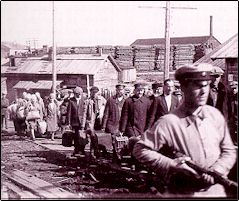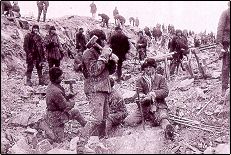Forced Labor Camps
o n - l i n e e x h i b i t i o n
O p e n S o c i e t y A r c h i v e s
The system of forced labor camps was established in the first years of the Communist regime in the Soviet Union. It became essential part of the Soviet repressive system. The Communist takeovers in the Eastern and Central Europe during the World War II led to mass arrests of non-Communist politicians and people identified as class-enemies. Many of them were sentenced to forced labor camps. In 1952 the International League for the Rights of Man was able to document the existence of more than 400 forced labor camps in Central and Eastern Europe. Here you can find highlights of the Open Society Archives hodings related to the Gulag and other forced labor camps.
The work is still in progress. For further information please see Forced Labor Reference Information Paper or send email to archives@ceu.hu
Original web site for the Gulag exhibition is www.osa.ceu.hu/gulag
25 September, 2003Solovki
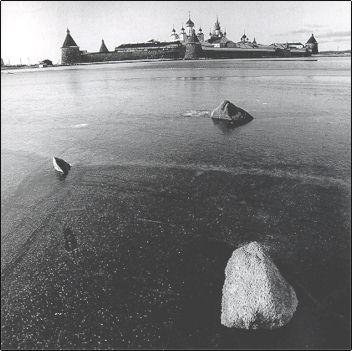
|
The Solovetsk Special Camp -- according to Aleksandr
Solzhenitsin -- may be considered as the "mother of the GULAG". This camp
was neither the biggest nor most brutal, yet it became a model camp where
the NKVD developed and tested security measures, "living conditions",
production norms for prisoners, and all possible methods of repression.
The exact number of prisoners who went through the camp during 1923-1939
is still unknown. Estimates range between tens and hundreds of thousands. Photo by Tomasz Kizny |
Read these documents to learn more about living conditions in the camp:
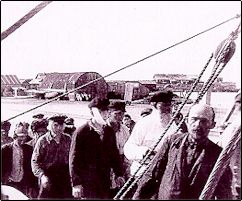 Transcript of the testimony by one of the witnesses about transfer to Solovetsk [Letters From Russian Prisons] |
Protest of
the "Kremlin Politicals" (Prisoners kept in the Kremlin of the
Solovetsk monastery were ironically called Kremlin Politicals) [Letters
From Russian Prisons]
|
Solovki is a symbol of the new system's attitude to religion and tradition.
Three historic monasteries located on a remote island in White Sea were turned
into a camp to isolate political opponents of the new regime: White Army
officers, members of opposition parties, participants of counter-revolutionary
uprisings.
Soon Solovetsk became one of the first "corrective labour camps". A wave
of repression of a scale never seen before brought hundreds of thousands
arrested people to camps, where their destination is to become a work-force
performing economic tasks.
At the end of 1936 the Solovetsk camp was reorganized into a prison and
then shut down in 1939 to make way for a naval base. The devastation of church
buildings continued well into the 1960s, when restoration work was initiated.
The influx of military families and conservators brought new life to the
islands. Today, the settlement around the monastery has a population of about
one thousand.
The Orthodox Church reestablished itself here in 1988, and in 1992 the
Solovetsk monastery complex was included in UNESCO's World Heritage List.
The only known iconographic record from the time of the camp's existence
is the propaganda film "Solovki", made in the Twenties for the purposes of
promoting the "new penitential policy of the Soviet State". Contemporary
photographs were taken on the Solovetsk Islands in June and October of 1993.
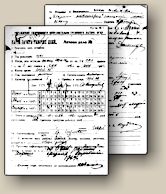 |
<<
zoom Prisoner's workbook kept record of work assignments completed: Solovki, 1926. [HU OSA 300-85-12] Related OSA holdings include: Solovki a documentary film [HU OSA 317-t70-0-1] |
Solovki served the NKVD as a model for developing and improving horrible practices soon to become a rule regulating the lives and deaths of tens of thousands of innocent people forced to create the "industrial miracles" of the Bolsheviks all around Russia.
Moving force of Soviet Industrialization
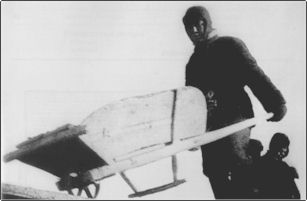
|
Tens of thousands of labor camp prisoners became the secret fuel of the Soviet Five-Year Plans and such giant projects as construction of the White Sea – Baltic Sea Canal, the Moscow River – Volga River Canal, the dam and power station at Dneprostroi, and the industrial center at Magnitka. |
| During the period of July 1929 - January 1, 1934, the number of prisoners incarcerated in labor camps increased 23 fold [Sistema ispravitel’no-trudovyjkh lagerei v SSSR. 1923-1960, p.35] |
 |

Letter
from Ordzhonikidze to Stalin, March 20, 1936
[Revelations
from the Russian Archives, p.162 ]
 Realm
of camp life: a prisoner’s workbook, 1952. The book belonged to Kaia, Lev
Isaakovich, managing engineer from the carbide plant in Grozny, arrested in
1942 (Article58), accused of anti-revolutionary sabotage and collaboration
with the German secret service. Sentenced to 10 years. Rehabilitated in 1957.
Realm
of camp life: a prisoner’s workbook, 1952. The book belonged to Kaia, Lev
Isaakovich, managing engineer from the carbide plant in Grozny, arrested in
1942 (Article58), accused of anti-revolutionary sabotage and collaboration
with the German secret service. Sentenced to 10 years. Rehabilitated in 1957.
View the book
| Official publications and periodicals represented slavory as a tool of reeducation changing people minds, turning them into dedicated builders of Communism. The newspapers below were distributed within labor camps only. | |
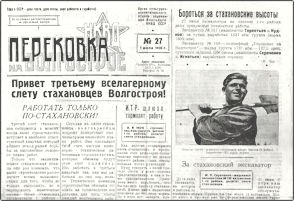 zoom "Perekovka" (Reshaping), Volgodon Canal construction [HU OSA 317, collection of Miklos Kun] |
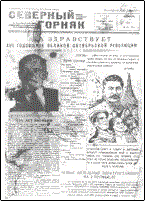 zoom "Severnyi Gorniak" (The Northern Miner), Komi region [HU OSA 300-85-42] |
Belomor-Kanal
| White Sea – Baltic Sea Canal was one of the first "great
construction projects of Communism", which relied exclusively on the
labour of prisoners. At Stalin's instructions work should be fast and inexpensive. Over 100,000 prisoners equipped with pick-axes, wheelbarrows and hatchets - dug a 227-kilometre long canal linking the Baltic and the White Sea in 20 months between 1931 and 1933. Tens of thousands died in the process. Sailing on the steamship Anokhin for the inauguration of the canal, Stalin concluded to his disappointment that the canal was too narrow and not deep enough for his liking and ordered a bigger one to be built. The blueprints were ready by 1936 but the project was never implemented. Ice-bound for half the year and too small for maritime vessels, the White Sea Canal never served any significant economic or strategic function. |
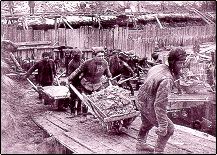
|
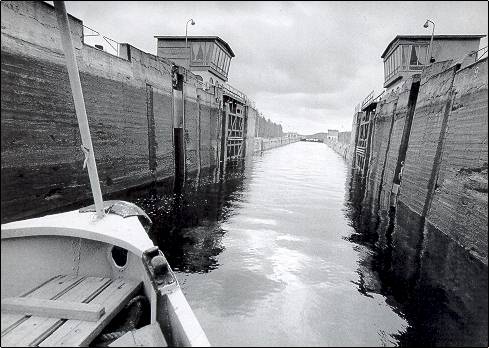
Photo by Tomasz Kizny
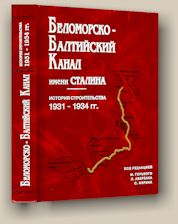 |
Published in 1934, destroyed in 1937, reprinted in 1998, this book was ordered by the OGPU to praise the success of "corrective labor" practices during the construction of the Canal. It was edited by Maxim Gorky and written by well-known soviet writers ot the time. The book constitutes stories written after multiple field trips, written at the time, when construction was under way. It is symbolic, that many of the heroes of the book and its authors alike did not survive the purges of 1937-1938. |
New dimensions of construction projects demanded more man-power, more "enemies of the people". This lead to a new round of prosecutions, political trials, and mass arrests.
When the West learned about the Gulag
Soviet labor camps were surrounded with walls and barbed wire, and hidden by a policy of secrecy and enforced silence. With very few notable exceptions the Soviet media avoided the topic of the GULAG system. Prisoners, entirely cut off from their homes and families, were doomed to die in obscurity and isolation of exhaustion, hunger and cold. Any communication with relatives was subject to severe limitations and censorship. However, prisoners tried to send information about their unhumane state by any means possible
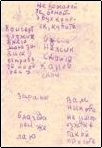 |
A message found on a road, and then sent to the relatives
of the condemned. 1939. Barshchevskii, Anatolii Mikhailovich was an economist for the Soviet Union’s Central Executive Committee’s People’s Economic Soviet. Arrested in 1938 (paragraph 58). Sentenced to eight years hard labor in Magadan. Died in the camp in 1943. From collection of the Memorial |
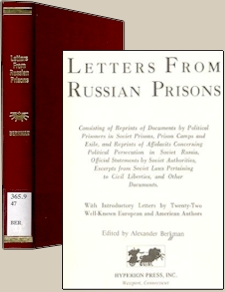 |
Some letters about labour camps and their prisoners were smuggled out of the Soviet Union and were published as early as in 1925. Letters from Russian Prisons contains over hundred letters and the testimony of political prisoners from the Soviet Union. The authors of this testimony were members of "persecuted revolutionary parties" - Social Democrats, Social Revolutionaries, and Anarchists. The book also includes the first printed maps of the GULAG, excerpts from Soviet legal documents, and material evidence such as GPU forms, labor camp tags, etc. |
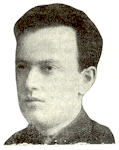 |
Image of the original letter |
Before publishing the book, its compilers sent the manuscript to a group of "celebrated intellectuals". Their responses, which follow, were published in it.
 |
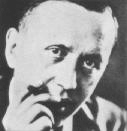 |
| Albert Einstein: "They [the Soviet authorities] will lose the last shred of sympathy they now enjoy if they are not able to demonstrate through the great and courageous act of liberation that they do not require this bloody terror in order to put their political ideas in force" | Karl Chapek:"You say that the world’s bourgeoisie is against you; but a greater force than that is opposed to you, the conscience of the world is against you." |
Emigre periodicals regularly contained letters and stories about political trials and labor camps:
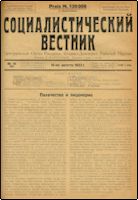 |
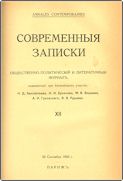 |
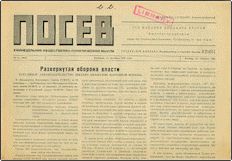 |
|
Sotsialisticheskii vestnik
|
Sovremennye zapiski
|
Posev
|
Information about the horrible practice of labour camps in the Soviet Union was, if not widely known, yet available long before The Gulag Archipelago was published by Alexander Solzhenitsyn in 1974.
Forced Labor Camps in the Communist Countries
Even though the Gulag is commonly associated with Stalin's Russia and Siberia, numerous camps existed all around the Soviet Union and other Communist Countries. Export of the forced labor system began as early as 1940. The first arrests and deportations took place in the Baltic countries even before they were incorporated into the USSR on August 3, 1940. After the reoccupation of the Baltic countries by the Soviet Union at the end of 1944, the first labor camps were established there. By 1953 there were 41 camps in Estonia, 6 in Latvia, and 9 in Lithuania.
Every assumption of power by communists was accompanied by mass arrests aimed primarily at the elimination of the opposition. Some prisoners were interned and others were assigned to forced labor.
Location of labor camps in the USSR published by an American publishing house, based on Polish sources including: 14,000 afidavits, original lists, and documents collected by the army of General Anders. [HU OSA 300-50-1]
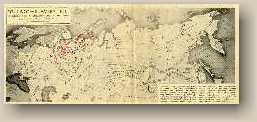 |
The American publisher wrote the following caption under the map: "We will give $1,000 to anyone who can prove that these documents are fakes. We have not yet heard from anybody to whom this publisher would have to pay the $1,000." |
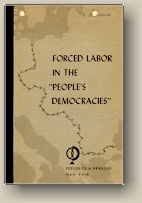 |
Forced Labor Camps in the "People’s Democracies" [HU OSA 300-9] contains maps and systemized data about multiple camps and represents an analysis of the forced labor system in these countries. |
|
Number of forced labor camps between 1948-1954 |
|
| Hungary | 199 |
| Czechoslovakia | 124 |
| Bulgaria | 99 |
| Romania | 97 |
| Poland | 47 |
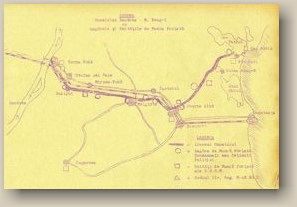 |
Map of the Danube-Black Sea Canal, a Romanian counterpart of the White Sea Canal [HU OSA 300-60-1] |
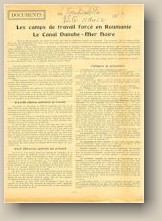 |
Article from the November 15, 1952 issue of Le Syndicaliste Exile, published by the Centre International des Syndicalistes Libre en Exil, which gives an accurate and up-to-date description on the numerous forced labor camps along the Danube-Black Sea Canal in the period 1949-1951 [HU OSA300-60-1] |
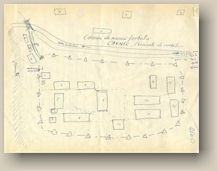 |
Map and explanation made by a prisoner of CAVNIC, a forced labor camp in Northern Transylvania, Romania, around 1956 [HU OSA 300-60] |
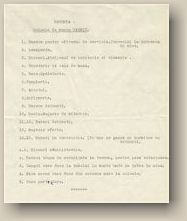 |
transcript |
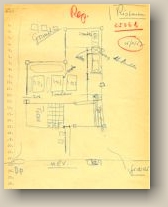 |
Sketch of an internment camp at Kistarcsa, Hungary. Before the Revolution of 1956 the camp served as a labor camp and then was turned into an internment camp for revolutionaries. [HU OSA 300-40-3.Item 2506b] |
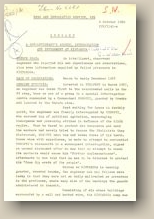 |
Personal story reported by a Hungarian revolutionary about his arrest, interrogation and internment at the Kistarcsa camp, in Hungary [HU OSA 300-40-3 Item No 5081] |
The Soviet Union and other Communist countries denied the existence of
forced labor within their borders, calling them instead "corrective" and
"re-educational" camps. In reality, these camps were used as a means of
political coercion and punishment for those holding or expressing opposing
political views.
On the other hand, prisoners of these camps had significant
economic importance in the planning and implementation of the economic
development plans of all communist regimes. The prisoners were
administratively assigned to those sectors of the state development plans
where manpower was in short supply.
 |
News From Behind the Iron Curtain [HU OSA 300-8]. Conditions in these forced labor camps varied from fair to incredibly bad, many camps earned the reputation of being "death camps" because of hight mortality rates due to the amount of labot exacted, and the brutal conditions under which it was performed. Hunger, brutality, fear, and death were companions of the forced laborer. |
After Stalin's death in 1953 several amnesties were granted in the communist countries of Eastern Europe. In 1956 the western press reported about strong indications that the whole labor camp system was undergoing revision. The internal forced labor systems had been greatly reduced and the remainder greatly modified, and numbers of the citizens of People's Democracies had been released from Soviet camps and returned home.Conditions in these forced labor camps varied from fair to incredibly bad, many camps earned the reputation of being "death camps" because of hight mortality rates due to the amount of labot exacted, and the brutal conditions under which it was performed. Hunger, brutality, fear, and death were companions of the forced laborer.
 Bela
Kemenyfi, a former Gulag prisoner, wrote a book called - ‘Hungarian
Scouts a Beyond the Arctic Circle’ (1989). It is a shocking
documentary of the time. At sixteen years of age its author was
practically a child when, following a short term as prisoner of war, he
was interned in the Hungarian-Soviet Interior Agencies’ prison. He was
shot in the spine while attempting to escape, but even the fact that he
had been crippled did not prevent Soviet authorities from condemning him,
and sending him through the hell of detention, penitentiary, and forced
labor camps. In 1953 the Supreme Court of the Soviet Union reviewed the
1946 sentence of the military court and rehabilitated Bela Kemenyfi. Bela
Kemenyfi, a former Gulag prisoner, wrote a book called - ‘Hungarian
Scouts a Beyond the Arctic Circle’ (1989). It is a shocking
documentary of the time. At sixteen years of age its author was
practically a child when, following a short term as prisoner of war, he
was interned in the Hungarian-Soviet Interior Agencies’ prison. He was
shot in the spine while attempting to escape, but even the fact that he
had been crippled did not prevent Soviet authorities from condemning him,
and sending him through the hell of detention, penitentiary, and forced
labor camps. In 1953 the Supreme Court of the Soviet Union reviewed the
1946 sentence of the military court and rehabilitated Bela Kemenyfi. |
Photograph and documents below are property of Bela Kemenyfi:
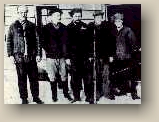 |
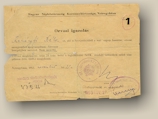 |
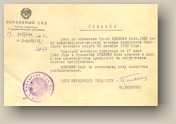 |
|
Hungarian and Russian prisoners, from left to right: Vaytov, Horvath,
Matushinka, Butin, and Nikolai. Sever, 1952. |
Medical certificate and ID paper issued by the Hungarian People’s Republic. November 1953. |
Rehabilitation document. December 30, 1960. |
Janos Rozsas became a soviet prisoner of war at 18 years of age, and spent nine years of his life as a political prisoner in various prisons and labor camps. Long after he became well for his friendship with Alexander Solzhenitsin. The writer mentions him by name in the first volume of his book "The Gulag Archipelago".
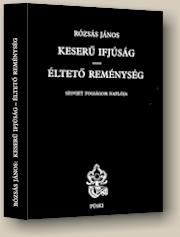 |
Janos Rozsas’ book was first printed in Munich in 1986 under the title ‘Bitter Youth’. A year later it was followed by the continuation of his story called ‘Life Giving Hope’. |
Letters sent from camps, property of Janos Rozsas:
|
|
This letter was written from the camp in Nikolaev with
the help of a Moldavian fellow prisoner. Rozsas purchased the paper of the
letter with half of his daily bread ration. May 1945. zoom |
|
|
Letter sent following Rozsas' release in 1953 on his
way home. zoom |
"In this ever-renewed hell of suffering, where I struggled in the agony
caused by starvation, cold and exhausting labor, it was only the knowledge of
my innocence, my unbreakable belief in the greatness of God, and the most
complete submission to His will which gave me the spiritual peace and calm
that enabled me to remain a human to the end."
-- Janos Rozsas
Additional information available from the Open Society Archives:
- Reference Information Paper #8: "Forced Labor Camps Under Communism"
- Selected Bibliography
Researchers from abroad can obtain copies of archival materials by mail. For details please visit www.osa.ceu.hu/guide/ or send email to archives@ceu.hu
Other related resources::
- "Gulag: A History" by Anne Applebaum at Amazon
-
On the Scope of Political Repression in the USSR under Stalin's Rule: 1921-1953
N.G. Okhotin, A.B. Roginsky; Memorial Society, Moscow, 2003. 7 pages. RTF in Russian, RTF in English - Documenting Women's Voices in Perestroika GULAG Narratives
By Benjamin M. Sutcliffe, Department of Slavic Languages and Literatures, University of Toronto.
Gulag [in Russian]
Online version of the Gulag study published in Moscow, 1998 -
Gulag Museum at Perm-36
The Gulag Museum is dedicated to promoting democratic values and civil consciousness in contemporary Russian society through the preservation of the last Soviet political camp as a vivid reminder of repression, and an important historical and cultural monument. - Memorial
Historical, Educational and Charitable Society -
Revelations from the Russian Archives
Consists of two parts: Internal Workings of the Soviet System (from Repression and Terror: Stalin in Control through Chernoblyl and Perestroika) and The Soviet Union and the United States (from Early Cooperation through Cuban Missile Crisis) -
Virtual Tour of the Monastery on Solovki by Sibelan Forrester
By Sibelan Forrester, Department of Modern Languages and Literatures at Swarthmore College.
